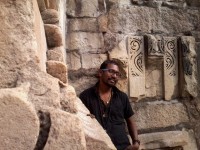Kumar Ranjan

Kumar Ranjan
ABOUT SELLER
Kumar Ranjan’s artwork speaks, and it speaks to the innocence and struggle of rural village, daily life. This is mirrored in Kumar Ranjan’s tale of becoming an artist. Kumar was born in the family of a village school teacher, in Godda district of Jharkhand, famous for Asia’s largest coalmine. This part of India is known for the rebellious Santhal tribe and the beautiful tribal art tradition of Jadupatua or magic paintings of Chotta, Nagpur. Kumar, although being a non-tribal, imbibed both the rebelliousness and the traditions of this mythical painting tradition. From his very early days Kumar learned that he could not communicate his thoughts well, which alienated him from his peers. But instead of transforming himself he started understanding this unique ambiguity in his expression and he came to realize that he had the talent of artistic creation. From here Kumar Ranjan’s long struggle to become an artist started. He tried to get admission into the art college but he failed in all the entrance exams. Undeterred, Kumar started painting on his own. He began with painting on jute (gunny cloth) and later shifted to canvas and paper. Kumar Ranjan accepted his childhood appreciation of Santhal tribal art. The imagery of this traditional art form shaped his aesthetic imagination, integrating into his creative expression the freshness of natural emotions free from the darkening ambiguity of the civilized world. Kumar Ranjan accepts that his art is very much influenced by village life. His Village Bazaar or Market Series tries to depict the facelessness of people in these areas and their appearance in congregation reflects that they all share same source of sadness and joy. His color palate is very rich. He uses bright Green, Orange, Blue, Lemon Yellow as the main colors in his compositions. Most of the time his subjects appear within a thick layer of a vibrant color scheme, especially his Village series which is very close to ‘Jadupatia’, traditional art form. The color scheme of ‘Jadupatia’ art is vivid and close to the rich landscape.


